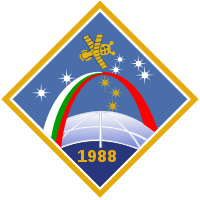- Mir EO-3
-
Mir EO-3 Number of crew Two Launch 11:18:03, 21 December 1987 (UTC) (TM-4) Launch site Baikonur Site 1/5 Launch craft Soyuz TM-4
Soyuz TM-6 (Polyakov)End 02:32:54, 21 December 1988 (UTC) Landing 09:57, 21 December 1988 (UTC) (TM-6) Landing craft Soyuz TM-6
Soyuz TM-7 (Polyakov)Mission duration 365.94 days[1] Previous expedition Next expedition Mir EO-2 Mir EO-4 Mir EO-3 (also called Mir Principal Expedition 3[2]) was an expedition to the space station Mir. The crew consisted of 3 people, Musa Manarov (Commander), Vladimir Titov (Flight Engineer) and Valeri Polyakov (Research Doctor). Manarov and Titov arrived at the station in December 1987 on Soyuz TM-4, while Polyakov arrived much later, in August 1988 on Soyuz TM-6. After the arrival of Polyakov, medical experiments became more intensive.
Contents
Crew
Upon docking to Mir; Titov and Manarov became the third resident crew. Both performed three EVAs. Polyakov joined the crew later separately.
Position Name Spaceflight Launch Landing Duration Notes Commander  Vladimir Titov
Vladimir TitovThird 21 December 1987
Soyuz TM-421 December 1988
Soyuz TM-6366 days Record spaceflight
durationFlight Engineer  Musa Manarov
Musa ManarovFirst Research Doctor  Valeri Polyakov
Valeri PolyakovFirst 29 August 1988
TM-627 April 1989
TM-7241 days Transferred to Mir EO-4 Backup Crew
- Aleksandr Volkov (Commander)
- Aleksandr Kaleri (Flight Engineer)
- German Arzamazov (Research Doctor)
Mission Highlights
In the first week of the mission they performed biological experiments (with onions and fishes for example) and installed the Aynur biological crystal growth apparatus, which they had delivered to the station, into Kvant-1. Titov and Manarov conducted part of an ongoing survey of galaxies and star groups in the ultraviolet part of the spectrum using the Glazar telescope on Kvant. The survey required photography with exposure times of up to 8 minutes. Other work included Earth observation and experiments on the fields of materials sciences, meteorology, space technology, physiology, psychology, medical sciences and astronomical research, using the Marija-research apparatus. In total the crew performed over 2000 experiments.
Mir EP-2
Mir EP-2 
Mission insigniaCall sign Родни́к (Rodnik- Spring) Number of crew Three Launch 14:03:00, 7 June 1988 (UTC)[3] Launch site Baikonur Site 1/5 Launch craft Soyuz TM-5 Landing 10:13:00, 17 June 1988 (UTC)[3] Landing craft Soyuz TM-4 Mission duration 9.84 days[3] In June 1988, the spacecraft Soyuz TM-5 arrived at the station carrying the three person visiting crew of Mir EP-2. The crew consisted of two Soviets, Commander Solovyev and Flight Engineer Savinykh, as well as the Bulgarian research cosmonaut Aleksandr Aleksandrov (not to be confused with Soviet cosmonaut Aleksandr Aleksandrov, who was part of the long-duration Mir EO-2 crew).
Aleksandrov was the second Bulgarian to fly in space, the first being Georgi Ivanov, who flew on Soyuz 33. But Ivanov failed to reach the space station Salyut 6, as the mission was aborted prior to docking, due to an engine failure aboard his spacecraft Soyuz 33.[4] As a result, prior to EP-2, Bulgaria was the only Eastern European Soviet ally to not have one of its citizens visit a Soviet space station.[2] Aleksandrov became the first Bulgarian to visit a space station.
Mir EP-2 Name Spaceflight Launch Landing Duration Commander  Anatoly Solovyev
Anatoly SolovyevFirst 7 July 1988
Soyuz TM-517 July 1988
Soyuz TM-49.8 days Flight Engineer  Viktor Savinykh
Viktor SavinykhThird Research cosmonaut  Aleksandr Aleksandrov
Aleksandr AleksandrovFirst During his visit, Aleksandrov used nearly 2,000 kg of equipment delivered by Progress spacecraft to conduct 46 experiments in the Shipka program.
The visiting EP-2 crew returned to Earth about a week later in the spacecraft Soyuz TM-4, leaving TM-5 as the station's lifeboat.[3]
Polyakov arrives
Main article: Mir EP-3On 31 August 1988, the spacecraft Soyuz TM-6 arrived at the station, carrying the new EO-3 crew member Valeri Polyakov. Also on TM-6 was the two person crew of the visiting expedition Mir EP-3, consisting of the commander Vladimir Lyakhov, as well as the first Afghan cosmonaut Abdul Ahad Mohmand.
After about a week on the station, Lyakhov and Mohmand returned to Earth in Soyuz TM-5, leaving the fresh TM-6 spacecraft at the station as their new lifeboat.[5] During the descent of TM-6 there were some technical problems, resulting in some tense moments as well as a day-long delay in landing.[5] Nevertheless, they landed safely on 7 September.
Spacewalks
The first spacewalk (also known as "Extra-vehicular activity", or EVA) of EO-3 took place on 26 February 1988 (4h 25m) replacing a segment on a solar cell. The second EVA was on 30 June 1988 (5h 10m) in which the replacement of a detector block on the Kvant-1 module failed. New tools were delivered to the station and with this the same work was then successful on 20 October 1988 (4h 12m).
End of mission
Mir EO-3 officially concluded on 21 December 1988, when Manarov and Titov returned to Earth in the Soyuz TM-6 spacecraft. The mission in total lasted for 365.94 days, the third longest of all the expeditions. Polyakov stayed aboard the station, and was transferred to Mir EO-4.
See also
References
- ^ "Mir EO-3". Encyclopedia Astronautica. http://www.astronautix.com/flights/mireo3.htm. Retrieved 15 November 2010.
- ^ a b D.S.F. Portee (1995). "Mir Hardware Heritage". NASA. http://ston.jsc.nasa.gov/collections/TRS/_techrep/RP1357.pdf. Retrieved 10 November 2010.
- ^ a b c d "Mir EP-2". Encyclopedia Astronautica. http://www.astronautix.com/flights/mirep2.htm. Retrieved 26 November 2010.
- ^ "Salyut 6 EP-5-1". Encyclopedia Astronautica. http://www.astronautix.com/flights/sal6ep51.htm. Retrieved 15 November 2010.
- ^ a b "Mir EP-3". Encyclopedia Astronautica. http://www.astronautix.com/flights/mirep3.htm. Retrieved 15 November 2010.
Expeditions to Mir Categories:- Mir
- 1987 in the Soviet Union
- 1988 in the Soviet Union
Wikimedia Foundation. 2010.
